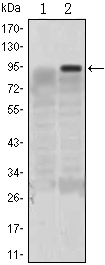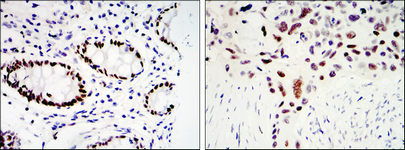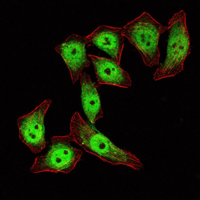GKLF Monoclonal Antibody
- Catalog No.:YM0308
- Applications:WB;IHC;IF;ELISA
- Reactivity:Human
- Target:
- GKLF
- Fields:
- >>Signaling pathways regulating pluripotency of stem cells;>>Chemical carcinogenesis - receptor activation
- Gene Name:
- KLF4
- Protein Name:
- Krueppel-like factor 4
- Human Gene Id:
- 9314
- Human Swiss Prot No:
- O43474
- Mouse Swiss Prot No:
- Q60793
- Immunogen:
- Purified recombinant fragment of human GKLF expressed in E. Coli.
- Specificity:
- GKLF Monoclonal Antibody detects endogenous levels of GKLF protein.
- Formulation:
- Liquid in PBS containing 50% glycerol, 0.5% BSA and 0.02% sodium azide.
- Source:
- Monoclonal, Mouse
- Dilution:
- WB 1:500 - 1:2000. IHC 1:200 - 1:1000. IF 1:200 - 1:1000. ELISA: 1:10000. Not yet tested in other applications.
- Purification:
- Affinity purification
- Storage Stability:
- -15°C to -25°C/1 year(Do not lower than -25°C)
- Other Name:
- KLF4;EZF;GKLF;Krueppel-like factor 4;Epithelial zinc finger protein EZF;Gut-enriched krueppel-like factor
- Molecular Weight(Da):
- 55kD
- References:
- 1. Mol Cell Proteomics. 2008 Mar;7(3):499-508.
2. J Cancer Res Clin Oncol. 2008 Aug;134(8):891-8.
- Background:
- This gene encodes a protein that belongs to the Kruppel family of transcription factors. The encoded zinc finger protein is required for normal development of the barrier function of skin. The encoded protein is thought to control the G1-to-S transition of the cell cycle following DNA damage by mediating the tumor suppressor gene p53. Mice lacking this gene have a normal appearance but lose weight rapidly, and die shortly after birth due to fluid evaporation resulting from compromised epidermal barrier function. Alternative splicing results in multiple transcript variants encoding different isoforms. [provided by RefSeq, Sep 2015],
- Function:
- function:Transcription factor which acts as both an activator and repressor. Binds the CACCC core sequence. Binds to multiple sites in the 5'-flanking region of its own gene and can activate its own transcription. Required for establishing the barrier function of the skin and for postnatal maturation and maintenance of the ocular surface. Involved in the differentiation of epithelial cells and may also function in skeletal and kidney development.,similarity:Belongs to the krueppel C2H2-type zinc-finger protein family.,similarity:Contains 3 C2H2-type zinc fingers.,subunit:Interaction with the C-terminal domain of MUC1 enhances suppression of TP53/p53 transcription.,
- Subcellular Location:
- Nucleus.
- Expression:
- Cervix,Lung,Placenta,Substantia nigra,Tongue,
- June 19-2018
- WESTERN IMMUNOBLOTTING PROTOCOL
- June 19-2018
- IMMUNOHISTOCHEMISTRY-PARAFFIN PROTOCOL
- June 19-2018
- IMMUNOFLUORESCENCE PROTOCOL
- September 08-2020
- FLOW-CYTOMEYRT-PROTOCOL
- May 20-2022
- Cell-Based ELISA│解您多样本WB检测之困扰
- July 13-2018
- CELL-BASED-ELISA-PROTOCOL-FOR-ACETYL-PROTEIN
- July 13-2018
- CELL-BASED-ELISA-PROTOCOL-FOR-PHOSPHO-PROTEIN
- July 13-2018
- Antibody-FAQs
- Products Images

- Western Blot analysis using GKLF Monoclonal Antibody against HEK293 (1) and KLF4-hIgGFc transfected HEK293 (2) cell lysate.

- Immunohistochemistry analysis of paraffin-embedded colon cancer tissues (left) and lung cancer tissues (right) with DAB staining using GKLF Monoclonal Antibody.

- Immunofluorescence analysis of ECA109 cells using GKLF Monoclonal Antibody (green). Red: Actin filaments have been labeled with Alexa Fluor-555 phalloidin.



